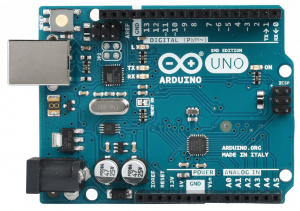Featured Tech – Arduino
Arduino Uno

Cost: $25
What is it?
Arduino is a simple microcontroller (programmable circuit board) that can integrate with a wide range of electronic devices. It is a great tool for prototyping projects that require manipulation of one or more electronic components. The Arduino consists of the physical board which is typically smaller than a playing card, and the IDE (Integrated Development Environment). The IDE is used to write and upload programs to the board.
Whereas most boards require another piece of hardware to upload a program, the Arduino can interface directly with a computer via USB connection. On top of this, it uses a simplified version of C++ which is a great introduction to the logic of programming. It’s versatility and simplicity make a great choice for beginner as well as those with more advanced projects in mind.
What can it do?
The Arduino is capable of supplying power to a circuit with 3.3 and 5 volt pins. With multiple ground pins, simply attach a wire between the appropriate pins and breadboard and you can have a fully functional circuit. (More info on circuits) The Arduino also has analog pins which can read input from analog devices such as a temperature or humidity gauge. There are also 14 digital pins which can either read or write digital inputs or outputs. This allows the Arduino to receive information such as whether or not a button has been pressed, as well as to give instruction to activate a device wired to the board.
There are a massive variety of sensors that are built to function with Arduino and there are several kits at the Hackerspace that feature many of them. Some examples include: flex sensor, motion sensor, light sensor, pressure sensor, and accelerometer. Any of these sensors can be used to provide input for controlling other devices such as visual displays, lights, and sound systems.
Examples of projects:
1). Secret Knock Detector – The Arduino has been wired to operate the locking mechanism of a door. When someone knocks in the correct sequence, it will unlock the door.
2). LED Cube – Create a dazzling light show by arranging LED lights into a cube and then blinking them on and off in a variety of sequences.
3). Solar Powered Robot (SOBO) – Lincoln is using an Arduino to power servo motors to operate a robot created with 3D printed parts from the Hackerspace. The robot will eventually be able to detect optimal places to charge using its solar panels. This project will be featured as more progress is made.
If you are interested in doing any work with Arduinos, stop by the Hackerspace! We have plenty of boards, wires, and sensors for you to experiment with. We also have a starter guide and a new “starter station” available where you can walk through step by step instructions on how to set up a circuit and write a basic program for operating the on-board LED.
